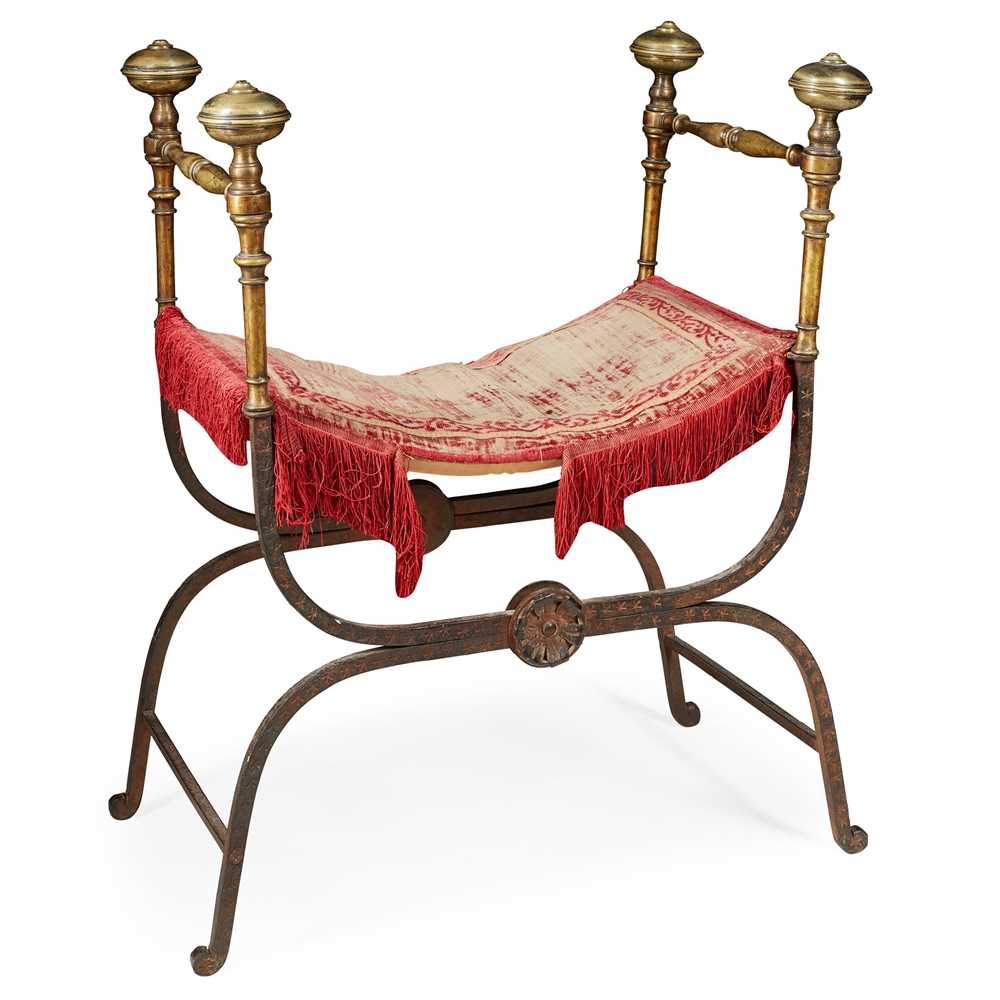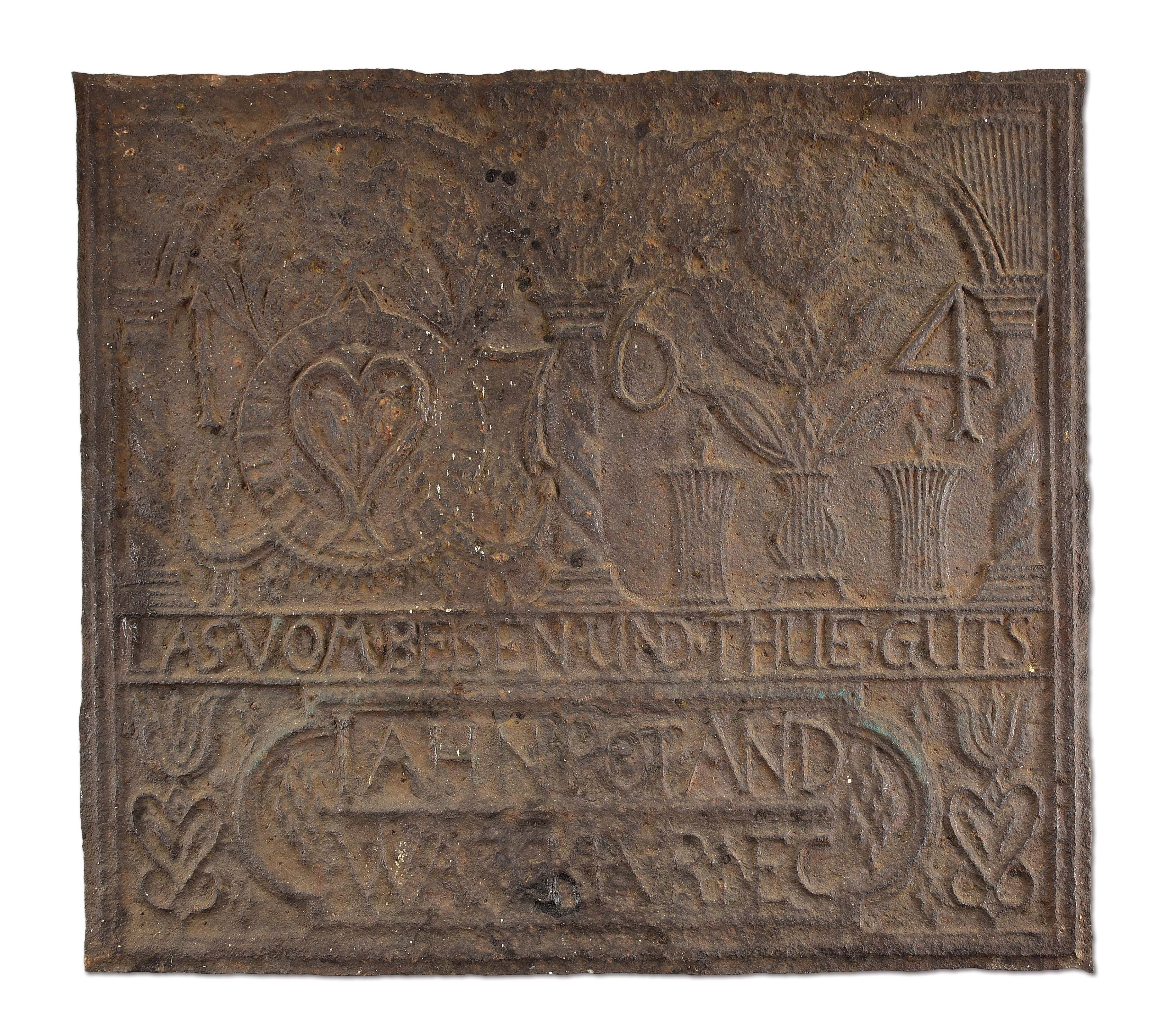An interesting Continental iron-framed weight-driven wall clock, inscribed with initials F.H., probably Swiss provincial, bearing the date 1761 The rectangular movement with iron plates measuring 5 by 4 inches united by four rectangular section pillars pinned through the backplate, the wheelwork with separately wound trains, the going with verge escapement regulated by 8 inch disc bob pendulum and the strike with outside countwheel, nags head lifting for the single-arbor warnless mechanism incorporating cam applied to the second wheel arbor for overlift and sounding via a vertically pivoted hammer on a bell attached above the case top board, the strike detent arbor applied with a decorative pierced and engraved brass gate inscribed F.H., the 9 inch painted iron rectangular dial with gilt rosette decorated centre within applied cream painted Roman numeral chapter ring with Arabic five minutes to outer track and pierced brass hands, the lower section with pendulum aperture within scroll painted panels and bearing inscription 1761, St. B. to bottom edge, in a shallow break-arch case with generous cavetto moulded cornice over shaped raised frame moulded glazed front door, the rear with plain door, the base with shallow moulded skirt, (dial retouched, case rebuilt, no weights), 33cm (13ins) high excluding finials. The current lot is interesting in that the movement resembles those of the earliest pendulum timepieces made during the third quarter of the 17th century. The strike train however utilises the single-arbor warnless system incorporating nags head lifting and cam for overlift. From this it would be fair to say that the mechanism was made by a provincial craftsman who was conversant with the form and layout of pendulum clocks made in the previous century (perhaps by studying Huygens various printed works) and made the going train along these lines; but then incorporated a typically Germanic form of strike mechanism rather that the twin arbor warned system preferred by French and Dutch makers.
An interesting Continental iron-framed weight-driven wall clock, inscribed with initials F.H., probably Swiss provincial, bearing the date 1761 The rectangular movement with iron plates measuring 5 by 4 inches united by four rectangular section pillars pinned through the backplate, the wheelwork with separately wound trains, the going with verge escapement regulated by 8 inch disc bob pendulum and the strike with outside countwheel, nags head lifting for the single-arbor warnless mechanism incorporating cam applied to the second wheel arbor for overlift and sounding via a vertically pivoted hammer on a bell attached above the case top board, the strike detent arbor applied with a decorative pierced and engraved brass gate inscribed F.H., the 9 inch painted iron rectangular dial with gilt rosette decorated centre within applied cream painted Roman numeral chapter ring with Arabic five minutes to outer track and pierced brass hands, the lower section with pendulum aperture within scroll painted panels and bearing inscription 1761, St. B. to bottom edge, in a shallow break-arch case with generous cavetto moulded cornice over shaped raised frame moulded glazed front door, the rear with plain door, the base with shallow moulded skirt, (dial retouched, case rebuilt, no weights), 33cm (13ins) high excluding finials. The current lot is interesting in that the movement resembles those of the earliest pendulum timepieces made during the third quarter of the 17th century. The strike train however utilises the single-arbor warnless system incorporating nags head lifting and cam for overlift. From this it would be fair to say that the mechanism was made by a provincial craftsman who was conversant with the form and layout of pendulum clocks made in the previous century (perhaps by studying Huygens various printed works) and made the going train along these lines; but then incorporated a typically Germanic form of strike mechanism rather that the twin arbor warned system preferred by French and Dutch makers.












Try LotSearch and its premium features for 7 days - without any costs!
Be notified automatically about new items in upcoming auctions.
Create an alert